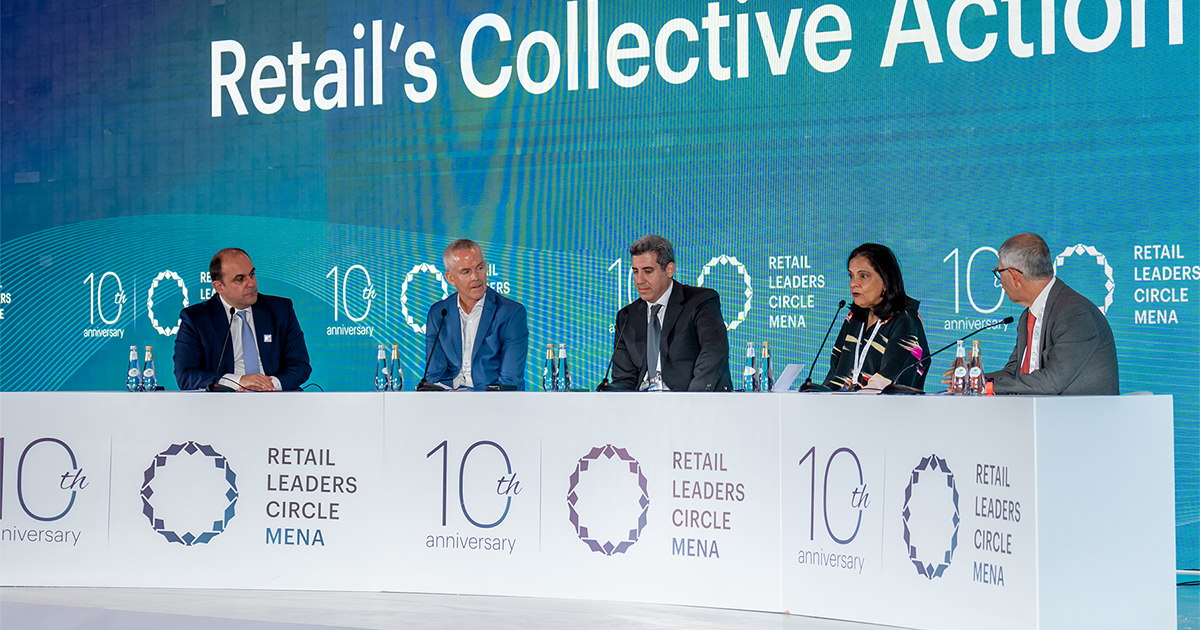Industry leaders Mohamad Mourad, MD & CEO, Cenomi Group, Renuka Jagtiani, Chairwoman, Landmark Group, John Hadden, CEO, Alshaya Group and Patrick Chalhoub, Group President, Chalhoub Group discussed the evolving landscape of the retail industry in the Kingdom of Saudi Arabia. The discussion was moderated by Panos Linardos, Chairman of the Retail Leaders Circle and shed light on the state of the industry, key disruptive forces, and the future outlook, building upon the conversations from the previous year.
The retail sector in the Kingdom of Saudi Arabia is at a crossroads, facing a unique set of challenges and opportunities that necessitate a strategic and holistic response. The necessity to adapt to evolving consumer behaviors, to embrace digital transformation comprehensively, and to enhance the overall customer experience forms the bedrock of strategies aimed at ensuring future growth and sustainability in the retail landscape.
Digital Transformation and Ecommerce Evolution
The need for the retail industry to pivot towards digital transformation and ecommerce evolution is critical. The future landscape is imagined as one where only the highest quality or most cost-effective brands thrive, with others pivoting towards digital platforms to remain competitive. The sector faces a substantial developmental gap in local ecommerce, marked by challenges such as extended delivery times, inadequate customer experience, and a lack of local product offerings. This has temporarily given international ecommerce platforms an edge, yet there’s a consensus on the urgency for a Saudi-centric ecommerce initiative to strengthen local retailers. The envisaged strategy involves not only partnerships, such as the notable one between Cenomi and Trendyol, but also a collaborative approach to create a level playing field for fair competition and mostly the governmental support to address market disparities such as higher operational costs and regulatory hurdles for local players.
Retailers and landlords need to up their game and offer enhanced experiences through both physical stores and digital platforms. The integration of online and in-store channels, and investments in technology are not just about transacting online but about enhancing all facets of retail operations and customer interactions ensuring service quality across all shopping platforms.
Physical Retail: Innovations and Challenges
There is pressure on physical stores, which cannot be addressed anymore with traditional pricing strategies, in the face of rising costs related to real estate, wages, and inflation. This scenario demands innovative solutions beyond mere expansion, emphasizing the critical role of top-tier talent and visionary leadership in embracing retail innovations. Creating engaging customer experiences within shopping malls includes thoughtful design and technology integration to meet consumer expectations. The necessity of improving the in-store experience involves not just the physical layout but also the availability of products and the training of store associates. The challenges of maintaining a skilled and motivated workforce amidst high attrition rates highlight the need for workforce stability to ensure a consistent and quality shopping experience.
Consumer Behavior and Market Dynamics
Consumer behavior in Saudi Arabia exhibits significant shifts towards value or brand consciousness, influenced by global trends and local socio-economic factors. Retailers must adapt to these changing preferences, offering tailored experiences that cater to diverse consumer expectations. The increasing demand for personalized, convenient shopping experiences drives the need for retailers to adopt flexible, customer-centric strategies.
Market dynamics in Saudi Arabia are characterized by the diversification of consumer spending and the beneficial impact of increased female workforce participation on the retail sector. The need for retailers to employ more aggressive and innovative strategies to capture consumer interest and wallet share in a maturing market is emphasized. The importance of balancing the focus between physical stores and ecommerce to offer a seamless retail experience is also highlighted, pointing to efforts in store renovation, staff training, and the strategic expansion of ecommerce, which now constitutes a significant portion of business operations. The shift from transactional expatriate engagements to a more integrated, long-term developmental approach is vital for sustainable growth and necessitates strategic investment in leadership and team development to navigate the changing market dynamics effectively.
Strategic Focus and Future Priorities
Looking forward, understanding, and adapting to customer needs, enhancing product relevance, and significant investment in employee development emerge as key strategies. The sector faces the dual challenge of managing rising operational costs while simultaneously driving revenue and productivity. A balanced approach towards brand presence enhancement and sales maximization is advocated. Moreover, the importance of a supportive operational model is necessary for scalable, sustainable growth, with emphasis on agility for swift, decisive action and based on strong partnerships. Given the people-centric focused nature of the business, investment in developing, motivating, and retaining talent is vital for delivering exceptional service and achieving business objectives.
Collaboration as the Cornerstone of Success
The need for collaborative efforts between the public sector and businesses to create enhanced mixed-use spaces is highlighted, as well as for addressing the legal hurdles for local players. Financial challenges, including the escalating operational costs that outstrip revenue growth, are acknowledged, with a strategy focused on cost control and revenue enhancement proposed as essential for navigating these challenges. Substantial commitments to partner development, fostering mutually beneficial relationships, would create a scalable operational model that supports sustainable growth and secures a competitive position in the retail landscape.
Despite the outlined challenges, a strong sense of optimism remains about the future of retail in Saudi Arabia. The potential for local ecommerce, the opportunities presented by demographic shifts, and the positive economic indicators are viewed as advantages. The emphasis on innovation, customer experience enhancement, and strategic planning are identified as foundational priorities to effectively navigate market challenges and leverage opportunities for transformation and sustainable growth.
The future of retail in Saudi Arabia is envisioned as a dynamic interplay of digital innovation, customer experience enhancement, operational agility, and talent nurturing. Addressing the challenges of rising operational costs and the promising state of local ecommerce requires a concerted effort from both the public and private sectors to foster a competitive and sustainable retail environment. This multifaceted approach promises not only to meet the immediate market demands but also to position the sector for enduring success amidst a rapidly evolving retail landscape.
 I really think the ship has sailed on e-commerce. I don’t think we can stop it; we need to either embrace it or bet on it.
I really think the ship has sailed on e-commerce. I don’t think we can stop it; we need to either embrace it or bet on it.





